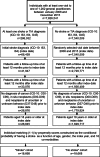Increased risk for cancer after stroke at a young age: etiological relevance or incidental finding?
- PMID: 31506741
- PMCID: PMC11810182
- DOI: 10.1007/s00432-019-03022-x
Increased risk for cancer after stroke at a young age: etiological relevance or incidental finding?
Abstract
Background: Etiological factors, such as a malignant disease, in young stroke patients are often neglected. Therefore, in this study, we aimed to investigate the risk of developing cancer in young stroke survivors.
Methods: The current case-control study sample included patients who received an initial ischemic stroke diagnosis documented in the Disease Analyzer database (IQVIA), which compiles data such as risk factors, drug prescriptions, and diagnoses obtained from general practitioners and specialists.
Results: The stroke and non-stroke groups included 18,668 patients each; each group had 2836 (15.3%) participants ≤ 55 years. The cancer incidence in the stroke group over the age of 55 years was higher than in the younger subgroup (29.4% versus 17.3%). The proportions of cancer patients within 10 years of follow-up were higher in the stroke group versus the non-stroke group, as well as in the subgroup of patients aged ≤ 55 versus patients > 55 years (17.3% versus 9.5% and 29.4% versus 24.9%, respectively). The calculated hazard ratio for developing cancer within 10 years of follow-up was higher in the younger stroke population (≤ 55 years) than in the older population (hazard ratio: 1.47 (CI 1.18-1.83) versus 1.17 (CI 1.10-1.25).
Conclusion: In our cohort, young individuals aged ≤ 55 years who suffered a stroke had twice as high risk for developing cancer within 10 years after the index event compared to the control group. Stroke might have implication regarding the subsequent development of cancer and vice versa.
Keywords: Cancer; Stroke etiology; Young stroke.
Conflict of interest statement
All authors report to have no conflicts of interest or competing interests related to the current manuscript.
Figures
Similar articles
-
Nutritional interventions for survivors of childhood cancer.Cochrane Database Syst Rev. 2016 Aug 22;2016(8):CD009678. doi: 10.1002/14651858.CD009678.pub2. Cochrane Database Syst Rev. 2016. PMID: 27545902 Free PMC article.
-
Are Current Survival Prediction Tools Useful When Treating Subsequent Skeletal-related Events From Bone Metastases?Clin Orthop Relat Res. 2024 Sep 1;482(9):1710-1721. doi: 10.1097/CORR.0000000000003030. Epub 2024 Mar 22. Clin Orthop Relat Res. 2024. PMID: 38517402
-
Impact of residual disease as a prognostic factor for survival in women with advanced epithelial ovarian cancer after primary surgery.Cochrane Database Syst Rev. 2022 Sep 26;9(9):CD015048. doi: 10.1002/14651858.CD015048.pub2. Cochrane Database Syst Rev. 2022. PMID: 36161421 Free PMC article.
-
Optimisation of chemotherapy and radiotherapy for untreated Hodgkin lymphoma patients with respect to second malignant neoplasms, overall and progression-free survival: individual participant data analysis.Cochrane Database Syst Rev. 2017 Sep 13;9(9):CD008814. doi: 10.1002/14651858.CD008814.pub2. Cochrane Database Syst Rev. 2017. PMID: 28901021 Free PMC article.
-
Does Augmenting Irradiated Autografts With Free Vascularized Fibula Graft in Patients With Bone Loss From a Malignant Tumor Achieve Union, Function, and Complication Rate Comparably to Patients Without Bone Loss and Augmentation When Reconstructing Intercalary Resections in the Lower Extremity?Clin Orthop Relat Res. 2025 Jun 26;483(9):1680-95. doi: 10.1097/CORR.0000000000003599. Online ahead of print. Clin Orthop Relat Res. 2025. PMID: 40569278
Cited by
-
Identification of a 6-RBP gene signature for a comprehensive analysis of glioma and ischemic stroke: Cognitive impairment and aging-related hypoxic stress.Front Aging Neurosci. 2022 Sep 1;14:951197. doi: 10.3389/fnagi.2022.951197. eCollection 2022. Front Aging Neurosci. 2022. PMID: 36118697 Free PMC article.
-
Epigenetic age and long-term cancer risk following a stroke.Genome Med. 2024 Nov 22;16(1):135. doi: 10.1186/s13073-024-01408-2. Genome Med. 2024. PMID: 39578904 Free PMC article.
-
Differences in healthcare visit frequency and type one year prior to stroke among young versus middle-aged adults.BMC Health Serv Res. 2021 Jan 22;21(1):84. doi: 10.1186/s12913-021-06064-5. BMC Health Serv Res. 2021. PMID: 33482779 Free PMC article.
-
The crosstalk between Stroke and Cancer: Incidence of cancer after a first-ever cerebrovascular event in a population-based study.Eur Stroke J. 2023 Sep;8(3):792-801. doi: 10.1177/23969873231181628. Epub 2023 Jun 15. Eur Stroke J. 2023. PMID: 37317526 Free PMC article.
-
Association of Stroke at Young Age With New Cancer in the Years After Stroke Among Patients in the Netherlands.JAMA Netw Open. 2023 Mar 1;6(3):e235002. doi: 10.1001/jamanetworkopen.2023.5002. JAMA Netw Open. 2023. PMID: 36976557 Free PMC article.
References
-
- Aarnio K, Joensuu H, Haapaniemi E, Melkas S, Kaste M, Tatlisumak T et al (2015) Cancer in young adults with ischemic stroke. Stroke 46:1601–1606 - PubMed
-
- Adams HP, Bendixen BH, Kappelle LJ, Biller J, Love BB, Gordon DL et al (1993) Classification of subtype of acute ischemic stroke. Definitions for use in a multicenter clinical trial. TOAST. Trial of Org 10172 in Acute Stroke Treatment. Stroke 24:35–41 - PubMed
-
- Aigner A, Busch MA, Grittner U (2017) Response by Aigner et al to letter regarding article, “Contribution of established stroke risk factors to the burden of stroke in young adults”. Stroke 48:e316 - PubMed
-
- Bergqvist D (2002) Venous thromboembolism in cancer patients: expanding horizons. Semin Thromb Hemost 28(Suppl 3):19–23. 10.1055/s-2002-34071 - PubMed
-
- Blom JW, Doggen CJ, Osanto S, Rosendaal FR (2005) Malignancies, prothrombotic mutations, and the risk of venous thrombosis. JAMA 293:715–722 - PubMed
MeSH terms
LinkOut - more resources
Full Text Sources
Medical



